
- Choosing Good Topics
- Controversial
- Demonstration
- Extemporaneous
- Informative
- School/College
- Special Occasion
- Public Speaking Help
- Writing a Speech
- Free Sample Speeches
- Share Your Speech

Persuasive Speech on School Uniform Policies

This persuasive speech makes some excellent points in favor of students having to wear school uniforms.
See if you can come up with even more arguments in favor of this idea - or how about a whole new speech arguing against the idea of mandatory school uniforms?
Make sure you start with a good speech outline to make it easier to keep track of any points you want to include in your statement.
Check out these tips on writing a persuasive speech as well. They'll help you to create a great presentation that might convince your audience to come around to your way of thinking!
Beginning of Persuasive Speech
Persuasive Speech entitled: The Case for School Uniforms
Should students be required to wear a uniform to school? That is the question that has been raised for discussion here today.
Private schools have long been known for having school uniform policies. Now some public schools such as ours are deciding whether or not they want their students to wear a school uniform.
Some people argue that requiring students to dress a certain way takes away their sense of creativity and individuality. However, there are several strong arguments in favor of schools requiring school uniforms.

Wearing a school uniform can encourage some students to take their responsibilities more seriously.
If they wear the same clothes to school that they wear when they go to the mall with their friends, they may have the same laid back attitude in both places.
Wearing "work clothes" to school can change the students' frame of mind and inspire a more serious attitude that is focused on study.
School uniforms can also lessen the negative effects of class status. In some schools you are only popular if you wear the latest fashions and trends.
Students are sometimes left out or even teased if they are unable or unwilling to pay to dress the way the popular students are dressing. Requiring students to wear a school uniform levels the playing field, by reducing the implied class status that is created when only certain students can buy the most expensive clothes.
Not only is teasing decreased, but violence can also be prevented at schools that have a required uniform.
Gang violence is becoming more prevalent at schools around the country. Sometimes fights can start over someone wearing the "wrong color" or gang symbol. There have even been instances of gang members sneaking into schools to recruit or harass students.
Required school uniforms can reduce fighting among students and prevent outsiders from being able to get into the school undetected.
Some opponents of school uniforms worry about the cost, but uniforms can actually cost less than other school clothes.
With regular clothes you usually buy a different outfit for each day of the week. You may even buy more than that. With a school uniform you can just purchase a few items, as you don't have to worry about wearing something different each day. You can also pass school uniforms down to family members, or find them on sale from other families.
There is a lot of controversy over whether or not school uniforms should be required. However, when you look at the facts you will see that there are many benefits to students all wearing the same thing to school.
Students may take school more seriously, teasing and violence can be decreased, and you may even save some money.

End of Persuasive Speech Supporting School Uniforms
I hope this persuasive speech has helped you to formulate some ideas on your chosen speech topic. Make sure you believe in the subject you have chosen to present to the audience and try to put yourself in the shoes of your listeners, thinking up any counter-arguments they may have, and addressing them!
Use the right words, and you'll find that persuading folks to think differently about your chosen topic is not as difficult as you may have thought it would be.
You might like these

Persuasive Topics for Valentines
The top five persuasive topics for Valentines day including commercialization, paternalism, inclusiveness, and religion

Fun Persuasive Speech Topics
Here are 54 fun persuasive speech topics for your consideration, around which you can create a light-hearted and entertaining speech.

Persuasive Speech Topics - Find Great Ideas for Your Presentation
Find lots of persuasive speech topics and discover how to influence your listeners' beliefs, change their opinions and ultimately prompt them to take action!
Free email delivery
MASTER INFORMATIVE SPEAKING WITH OUR FREE CHECKLIST!
We are offering you a FREE SpeakFlight Informative Speaking Preparation Checklist. This valuable resource is packed with step-by-step guidance to help you create compelling, memorable, and effective informative speeches.
Share this page
Related persuasive speech topics, tips, and techniques.
More tips...
- A Guide to Persuasive Speech Writing
- More Tips for Writing Good Persuasive Speeches
- Tips for Creating Your Outline (With Example)
- Another Example Outline
- 3 Tips for Writing a Speech That Gets Results
Brainstorming techniques...
- Coming up With Ideas
- More Ways to Find the Perfect Topic
Topics to try...
- Ideal for Teens
Example persuasive speeches for inspiration...
- Gender Selection
- Energy Medicine
- The Role of Marriage in Society
- Fun Speech about Luck
- Second-Hand Smoke Using a Cell Phone Whilst Driving
- Become an Activist
- Best Speech Topics
- Persuasive Speech Topics
- Sample Persuasive Speech - Uniforms

Easily search your speech type
Just check out the sitemap for best-speech-topics.com , which lists all the pages on the site, or use the search box below:
Return to the Top of the Page
Get to Know Us
- Privacy Policy
Attention Grabbers
- Positive Quotes for Kids
- Quotes for Graduation Speeches
- Poems & Quotes on Death
- Quotes on Retirement
Most Popular Pages
- Free Samples
- Good Speech Topics
- Hypnotize Your Audience
- Welcome Speech
Select a Speech Topic
- Argumentative
- Commemorative
- Inspirational
- Interesting
- Other Topics
Let Us Help You
- How To Write a Speech
- Demonstration Outline
- Informative Outline
- Introductions
- Using a Microphone
- Speech Help
- Speeches Made Easy

Home » Tips for Teachers » Why Students Should Not Wear Uniforms: A Thoughtful Exploration with 9 Reasons, Studies and Statistics
Why Students Should Not Wear Uniforms: A Thoughtful Exploration with 9 Reasons, Studies and Statistics
In the ongoing debate about school uniforms, a significant voice often goes unheard – that of the students themselves. The argument against mandatory school uniforms is not just about fashion or personal preferences; it delves deeper into fundamental issues of self-expression, equity, and the very purpose of education. This article, “Why Students Should Not Wear Uniforms,” seeks to uncover the less discussed but crucial aspects of this debate, presenting a comprehensive view that challenges the traditional perspective favoring uniforms.
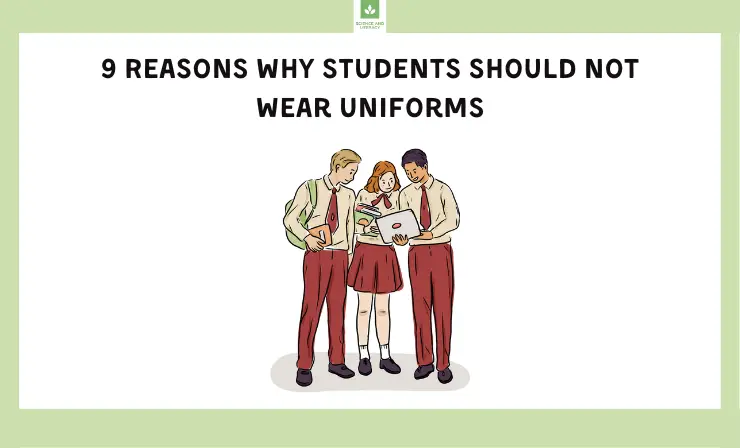
At the core of the anti-uniform stance is the belief in the importance of individuality and personal growth during the formative years of schooling. Uniforms, often seen as a tool for homogenization, can stifle the self-expression and creativity that are essential in nurturing young minds. By enforcing a standard mode of dress, schools may inadvertently suppress the diversity and individuality that should be celebrated within educational environments. Moreover, the imposition of uniforms can raise significant financial burdens for families, create unnecessary resistance to authority, and overlook important cultural and religious considerations.
I am seething about this poor young girl who has been put in isolation because she’s not wearing a school uniform bought from the right place, school uniforms are far too expensive for a lot of people in this country in the most ridiculous you can get just as good from supermarke — James Whale (@THEJamesWhale) September 17, 2023
This article aims to explore these perspectives, offering insights into why the policy of mandatory school uniforms might be an outdated approach that overlooks the broader objectives of education and personal development. As we delve into this topic, we invite readers to reconsider the conventional wisdom on school uniforms and reflect on the potential benefits of a more flexible and inclusive approach to student attire.
After reading this article you’ll know:
- Educator and Industry Expert Perspectives →
- 9 Reasons Why Students Should Not Wear Uniforms →
- Opposing Perspectives on School Uniforms →
Uniforms in Education: Educator and Industry Expert Perspectives
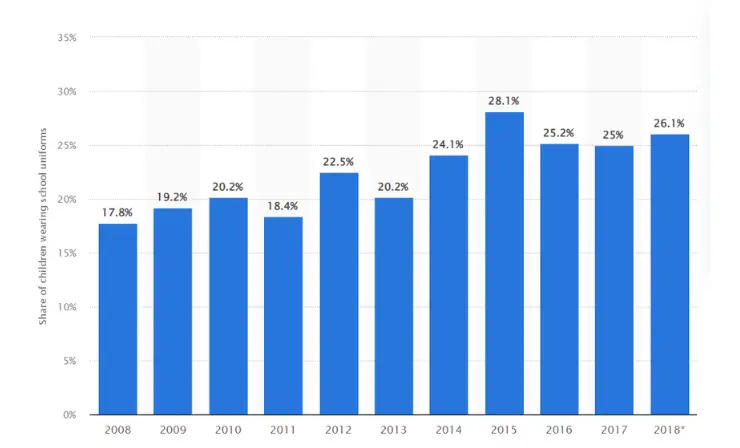
Teachers and educational experts are increasingly questioning the rising trend of school uniforms in U.S. public schools. While the period from 1999-2000 to 2017-18 saw an increase from 12% to 20% in schools adopting uniforms, there’s growing concern about their impact on student individuality and expression. In 2015-2016, uniform policies were enforced in 25% of public primary schools, 20% of middle schools, and 12% of high schools, with a notable prevalence in urban and high-poverty schools . Experts argue that such policies, while aiming for uniformity, might inadvertently suppress student creativity and self-identity, vital for holistic educational development.
Here’s the perspective of educational field experts on the matter:
“I completely disagree with uniforms on every level. Supporters of uniforms say that they reduce bullying with regards to fashion, but there is a great deal of evidence that says it just pushes that bullying underground. Instead of being bullied about something superficial like the shirt you are wearing, bullies just go to the tried and true body image shaming. Glass? Overweight? Acne? Too many freckles? Hair colour? Too tall? Too short? What school administrators see is a surface level reduction in bullying, followed by them patting themselves on the back and ignoring the problem completely.” — Scooter Campbell , assistant language teacher
“While uniforms are supposed to build a sense of community, they may have the opposite effect. Fashion is one way that students express themselves, and that may be an important part of the school experience. When students can’t show their individuality, they may not feel like they belong as much. School uniforms may not be the most effective way to improve student behavior and engagement.” — Arya Ansari, assistant professor of human sciences at The Ohio State University
“I really don’t care whether or not a student’s shirt is tucked in, as long as they are learning. I don’t care whether or not a student has on the right belt, as long as I can’t see their underwear. I don’t care if a boy has earrings, facial hair, or painted nails, as long as he’s not painting them in my class. I don’t care if a girl has bright pink hair, a tank top, and ripped jeans, as long as bosoms and butt cheeks are covered and secure. I don’t like hoodies on heads in my classroom because it makes it too easy to hide Airpods, but I don’t care if the sweatshirt has a hood. As long as it’s not a top hat or sombrero that blocks the view of the students behind them, I don’t care if my students wear hats or beanies in my class.” — New Orleans Mom Guest Author
The video below explores the debate on the impact of school uniforms on academic performance. It delves into whether mandating uniforms in schools truly enhances students’ learning and overall academic success.
Want to know how to be a strict teacher? Read our dedicated article .
9 Reasons Why Students Should Not Wear Uniforms
Let’s explore the reasons against mandating school uniforms for students. Understanding these arguments provides valuable insights into the broader educational and social implications of uniform policies.
1. Expression of Individuality
The concept of “Expression of Individuality” in the context of school uniforms is a vital aspect of student development and autonomy. When schools impose uniforms, they inadvertently restrict a key channel through which students express their individuality and creativity. This freedom of expression is not merely about fashion or aesthetics; it’s a crucial part of a student’s journey towards self-discovery and confidence building.
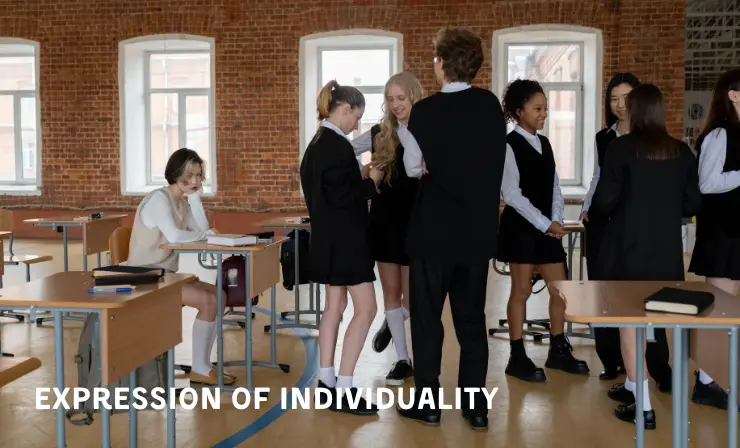
Key aspects of individuality expression through clothing include:
- Personal Identity Formation: Choosing what to wear allows students to explore and affirm their personal identities and tastes.
- Creativity and Innovation: Fashion is a form of art. Allowing students to select their own clothes fosters creativity and innovation, skills highly valued in many aspects of life and work.
- Cultural Expression and Diversity: Clothing can be a powerful expression of cultural heritage. A diverse dress code celebrates and acknowledges the rich tapestry of cultures in the student body.
Beyond these points, individuality in clothing choices helps prepare students for future environments where they must make decisions about their personal and professional presentation. In many modern workplaces, the ability to express oneself appropriately through attire is valued and can impact career progression and personal branding.
Furthermore, enforcing a uniform policy can subtly imply that conformity is more important than individual thought and expression. This is at odds with the educational goal of fostering independent, critical thinkers who will contribute uniquely to society.
In essence, the freedom to choose one’s attire is not just a matter of personal taste but a crucial element in nurturing confident, creative, and culturally aware individuals. Schools, by embracing this diversity in student clothing, can enhance the educational experience and better prepare students for the varied and diverse world beyond their gates.
2. Financial Burden
The requirement of school uniforms can impose a significant financial burden on families, an aspect that often gets overlooked in the uniform policy debate. In the United States, over half of parents , at 55%, perceive school uniforms to be costly. This financial strain is not just about the initial cost of purchasing uniforms, but also encompasses several hidden expenses that accumulate over time.
Key points illustrating the financial burden of school uniforms include:
- Initial and Replacement Costs: Uniforms, especially those with specific designs or logos, can be expensive to buy. Additionally, as children grow or uniforms wear out, they often need replacing, adding to the financial strain.
- Multiple Sets Requirement: To maintain a clean and presentable appearance throughout the week, families typically need to purchase multiple sets of uniforms, further escalating the cost.
- Special Care and Maintenance: Some uniforms require special laundering or care, which can add to the overall expense, either in terms of higher home utility bills or professional cleaning services.
Moreover, these costs can be particularly burdensome for families with multiple children or those on a limited income. Research from the University of York highlighted that school uniforms present unmanageable costs for low-income families. The study found that purchasing uniforms imposed sudden and significant financial burdens, leading families to make sacrifices on essentials like food and heating, and in some cases, to enter into debt.
In addition to the direct financial impact, there’s also the consideration of opportunity cost. Money spent on uniforms could have been allocated to educational resources, extracurricular activities, or savings for future educational expenses.
In conclusion, the mandatory school uniform policy can lead to significant and often underappreciated financial pressures on families, making it a substantial reason for reconsidering such policies, especially in schools that serve economically diverse or disadvantaged communities.
3. Comfort and Practicality
The issue of comfort and practicality is a significant concern in the debate against mandatory school uniforms. Students spend a substantial part of their day in school, and their attire plays a crucial role in their overall comfort and ability to engage effectively in various school activities.
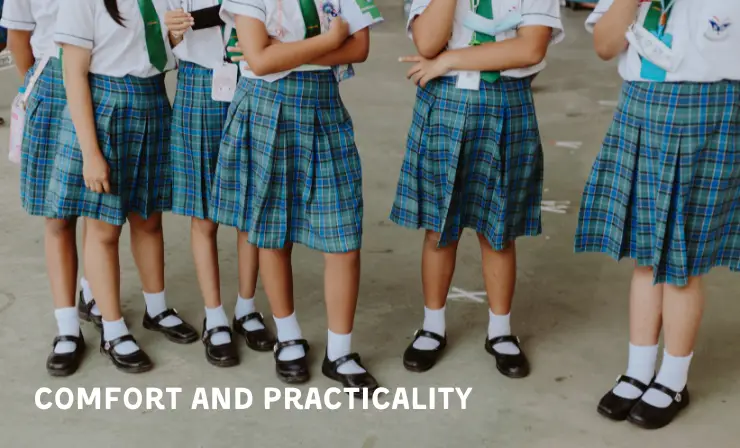
Key aspects highlighting the importance of comfort and practicality include:
- Physical Comfort: Uniforms, often designed with a one-size-fits-all approach, may not suit every body type, leading to discomfort. Comfortable clothing is essential for students to focus and participate actively in their learning.
- Suitability for Varied Activities: School life involves a range of activities, from sitting in classrooms to physical education and outdoor play. Uniforms might not be practical for all these diverse activities, impacting students’ ability to participate fully.
- Weather Appropriateness: Uniforms may not be designed for all weather conditions, which can affect students’ comfort and health. For example, a uniform might be too warm for summer months or insufficiently protective during colder weather.
Additionally, practicality concerns extend to the maintenance of uniforms. They often require regular washing and ironing, which can be time-consuming for families. Also, the need for specific uniform attire for different school events or days (e.g., physical education uniforms) adds to the complexity and impracticality of the uniform system.
In essence, prioritizing comfort and practicality in student attire is not only a matter of convenience but also impacts their academic engagement and well-being. Allowing students to wear clothing that is comfortable, suited to a variety of activities, and appropriate for the weather can enhance their school experience, making them more receptive to learning and participating in school life.
4. Lack of Preparation for Real World
The argument that school uniforms do not adequately prepare students for the ‘real world’ is increasingly relevant in today’s diverse and flexible professional environment. In many modern workplaces, the ability to choose and present oneself appropriately is a valued skill, reflecting individual judgment and adaptability.
Key points underscoring this lack of preparation include:
- Diversity in Workplace Attire: Modern workplaces often have varied dress codes, ranging from formal to casual. Uniform policies do not expose students to the decision-making process involved in dressing for different occasions and environments.
- Personal Branding: In many careers, personal style is an integral part of professional branding. Uniforms do not allow students to explore and develop their personal style, which can be a disadvantage in professions where self-presentation is key.
- Adaptability and Decision-Making: Choosing appropriate attire for different settings teaches adaptability and decision-making skills. Uniforms eliminate these daily choices, potentially leaving students less prepared to make such judgments post-graduation.
Norman Isaacs, the principal at Millikan Middle School in Sherman Oaks, California, opposes school uniforms . He argues that students should be taught to make decisions and choices rooted in their own values instead of adhering to arbitrary rules. He believes this approach is essential for students to develop independent thinking and self-discipline.
In conclusion, while uniforms might simplify wardrobe decisions during school years, they can inadvertently hinder the development of skills necessary for navigating the varied and often nuanced dress codes encountered in adult life, especially in professional settings. Allowing students the freedom to choose their attire is more aligned with preparing them for the real-world scenarios they will face after graduation.
5. Equality Issues
The topic of equality in relation to school uniforms is multi-faceted and complex. While uniforms are often championed as a tool for promoting equality, they can, in fact, inadvertently highlight and exacerbate existing socioeconomic disparities among students.
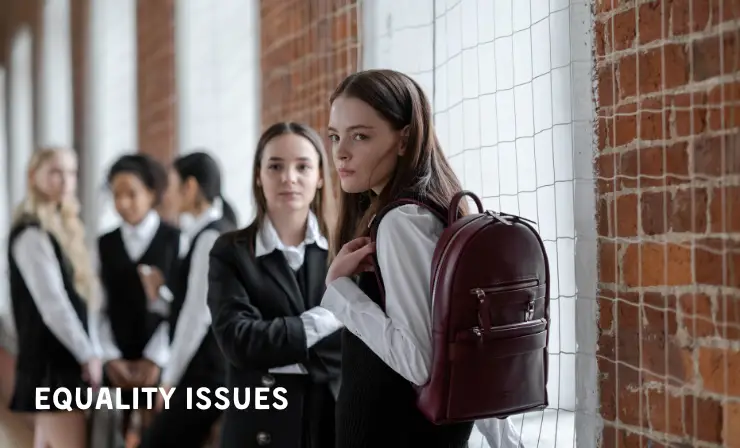
Key points illustrating the equality issues associated with school uniforms include:
- Highlighting Economic Disparities: The quality, newness, and upkeep of uniforms can become a marker of economic status. Students from less affluent backgrounds may struggle to keep their uniforms in pristine condition, inadvertently highlighting socio-economic differences.
- Access to Uniforms: The cost of uniforms can be prohibitive for some families, particularly those with multiple school-age children, leading to inequality in access.
- Uniform Assistance Programs: While some schools offer uniform assistance programs, reliance on such programs can inadvertently stigmatize students, creating a sense of otherness rather than unity.
Moreover, the notion that uniforms inherently promote a sense of equality among students is debatable. While uniforms may superficially level the playing field by unifying student attire, true equality and respect among students stem from an inclusive school culture that values diversity, not just from masking individual differences with standard clothing. For example, in schools like Archer , the uniform policy doesn’t restrict branded shoes or accessories, allowing students to display wealth through these items. This often leads to a sense of inequality, as students become aware of and feel pressured by the presence of expensive items, undermining the supposed leveling effect of uniforms.
In summary, while the intention behind school uniforms may be to create a level playing field, they can sometimes have the opposite effect by highlighting economic disparities and creating barriers to access. A more effective approach to promoting equality in schools involves addressing these deeper issues directly, rather than masking them with a uniform policy.
6. Resistance to Authority
The imposition of school uniforms can sometimes foster resistance to authority among students, particularly as they grow older and seek to assert their independence and individuality. This resistance is not just a matter of rebellion; it often stems from deeper feelings of autonomy and self-expression being suppressed.
Key points related to resistance to authority include:
- Asserting Independence : As children mature into teenagers, they naturally seek to express their individuality. Uniforms can be perceived as a restriction on this expression, leading to resistance as a form of asserting independence.
- Questioning Rules and Uniformity: Older students often begin to question the rationale behind various rules, including dress codes. Mandatory uniforms can become a focal point of this questioning, symbolizing a broader struggle against perceived unnecessary authority.
- Impact on Student-Teacher Relationships: Strict uniform policies can create an adversarial dynamic between students and school authorities, impacting the overall school environment and student-teacher relationships.
The resistance to uniforms and, by extension, to school authority, can have wider implications. It can detract from the educational experience, creating an environment of conflict and tension rather than one of learning and growth. Additionally, this resistance can carry over into other aspects of school life, affecting participation in school activities, respect for school rules, and overall school morale.
In essence, while the aim of school uniforms may be to promote discipline and unity, they can sometimes yield the opposite result, particularly among older students. Recognizing and respecting students’ growing need for self-expression and autonomy is crucial in fostering a positive and productive school atmosphere.
7. Cultural and Religious Concerns
Addressing cultural and religious concerns is crucial when considering the impact of mandatory school uniforms. Uniform policies can sometimes conflict with students’ cultural and religious practices, leading to feelings of exclusion and a lack of representation.
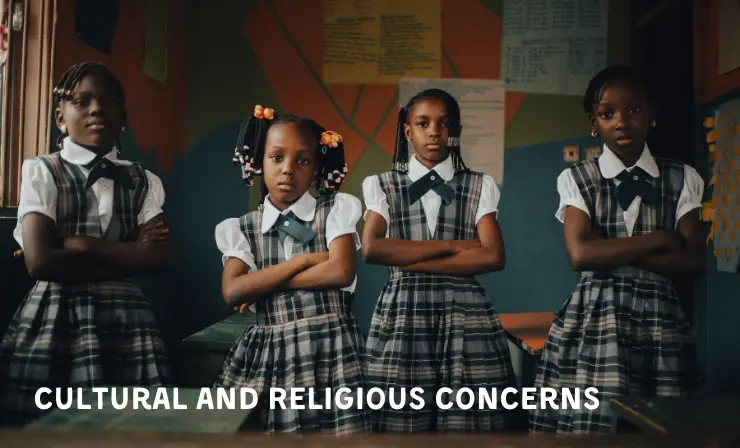
Key points highlighting cultural and religious concerns include:
- Respect for Cultural Attire: Many cultures have traditional attire that holds significant meaning. Uniform policies can prevent students from wearing these culturally important garments, leading to a loss of cultural expression.
- Accommodating Religious Dress Requirements: Some religions have specific dress codes, such as headscarves or particular garments. Uniforms that don’t accommodate these requirements can impede religious freedom and expression.
- Impact on Inclusivity and Diversity: A uniform policy that doesn’t consider cultural and religious diversity can create an environment where students feel their identities are not acknowledged or respected.
Furthermore, navigating these cultural and religious nuances requires sensitivity and understanding from educational institutions. When schools fail to accommodate such diversity, it can lead to a sense of alienation among students from different cultural or religious backgrounds. This alienation can affect their sense of belonging and engagement within the school community.
In summary, while school uniforms are often intended to create a cohesive and unified appearance, they can inadvertently undermine the rich cultural and religious diversity within the student body. An inclusive approach that respects and accommodates these differences is essential for fostering an educational environment that values and celebrates diversity.
8. Psychological Impact
The psychological impact of school uniforms on students is an important aspect to consider, particularly as it pertains to their self-image, confidence, and overall mental well-being. Uniforms, by their very nature of imposing a standard appearance, can have various unintended negative psychological effects on students.
Key points regarding the psychological impact include:
- Self-Image and Confidence: Uniforms can affect how students perceive themselves, especially if they feel the uniform is unflattering or doesn’t reflect their identity. This can lead to issues with self-esteem and confidence.
- Conformity vs. Individuality: The emphasis on conformity through uniforms may conflict with a student’s desire for individual expression, leading to internal conflict and stress.
- Stress on Families: The pressure to maintain a set standard of uniform can also place stress on families, particularly if they struggle financially or have time constraints, affecting the student’s home life and mental well-being.
Additionally, unflattering or restrictive uniforms can deter students from participating in sports , creating a psychological barrier. For example, an auto-ethnography highlighted the psychological barrier posed by an unflattering sports uniform to fat children’s participation in and enjoyment of physical activity.
In conclusion, while uniforms are often intended to eliminate distractions and create equality, they can have significant psychological impacts on students. These impacts can range from affecting self-esteem and personal identity to creating stress and anxiety. Considering these factors is crucial in evaluating the overall effectiveness and appropriateness of uniform policies in schools.
9. Not Environmentally Friendly
The environmental impact of school uniforms is an often overlooked yet critical aspect of the debate surrounding their use. The production, maintenance, and disposal of school uniforms carry significant environmental implications, making them a less sustainable option for student attire.
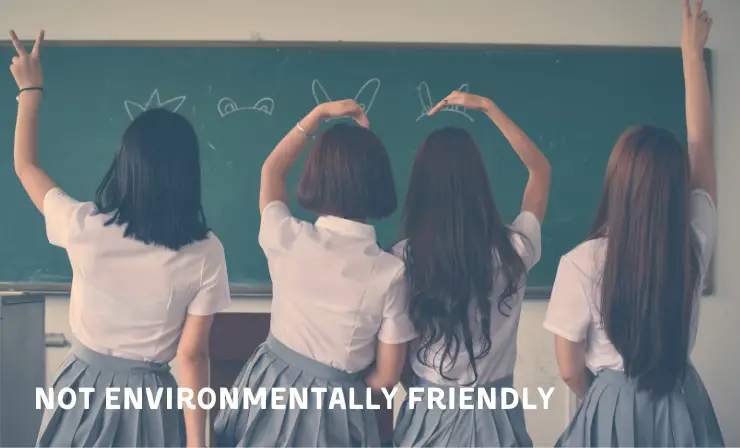
Key points highlighting the environmental concerns include:
- Resource-Intensive Production: The manufacturing of uniforms often involves resource-intensive processes, using materials that are not environmentally friendly and consuming large amounts of water and energy.
- Frequent Replacement and Waste: As children grow, uniforms need frequent replacing, contributing to textile waste. Unlike everyday clothing, which can be handed down or repurposed, specific school uniforms have limited use beyond the school environment.
- Chemical Usage in Maintenance: The maintenance of uniforms, especially those requiring special care, can involve the use of harsh chemicals and detergents, further contributing to environmental harm.
Furthermore, the environmental impact of uniforms extends beyond their production and maintenance. The disposal of outdated or worn-out uniforms poses a challenge, as they are often not made from biodegradable or recyclable materials, adding to landfill waste.
In summary, considering the environmental footprint of school uniforms is essential in the context of growing concerns about sustainability and environmental conservation. Moving towards more eco-friendly clothing options or implementing uniform recycling programs could be steps in mitigating the environmental impact associated with school uniforms.
Addressing Opposing Perspectives on School Uniforms
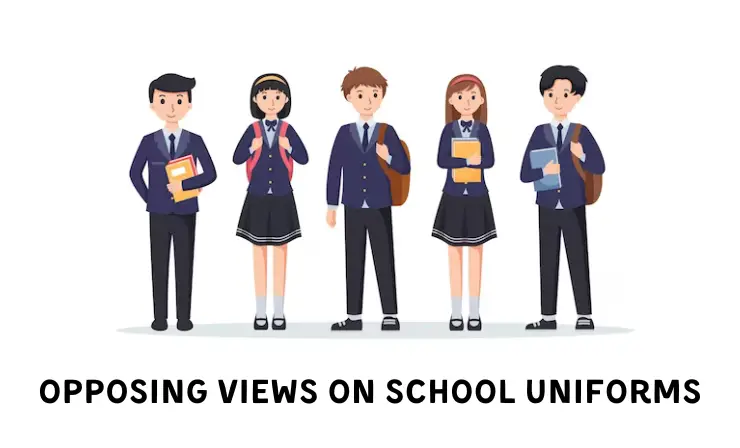
While the debate around school uniforms has varying opinions, it’s essential to consider the opposing views. Below, we explore common arguments in favor of mandating school uniforms, coupled with counterarguments that provide a different perspective on the issue.
1. Uniforms Save Time
The perceived time-saving aspect of school uniforms is often debated. While it’s argued that uniforms can save time in choosing outfits for school, this benefit is minimal as students still need casual attire for outside school hours.
Furthermore, uniforms can actually add to the workload of teachers . They often spend a significant amount of time enforcing uniform policies and addressing infractions such as improper dress. This enforcement can detract from the primary focus of teaching and reduce the time available for actual lesson delivery.
2. Uniforms Improve Attendance and Discipline
Proponents of school uniforms often claim they instill discipline by requiring students to adhere to dress codes. However, true discipline is more effectively cultivated through internal motivation and understanding the reasons behind rules , rather than mere conformity to a uniform. Encouraging critical thinking and self-discipline is more beneficial for students’ overall development.
This perspective is supported by research using data from the Early Childhood Longitudinal Study , which showed that school uniforms had no effect on students’ behavior across various dimensions, including internalizing and externalizing behavior problems, and social skills. This finding was consistent through kindergarten to the end of fifth grade, even after accounting for a range of factors that could influence behavior.
3. Improving Safety and Security
The argument that uniforms aid in identifying who belongs on campus and enhance security is subject to debate. While it may assist in spotting intruders, a more effective approach to safety involves a robust security system and active community engagement.
Fostering a safe school environment is better achieved through open communication and trust among students, staff, and the community. The effectiveness of uniforms in improving security is not universally acknowledged and is often viewed as a measure to enforce conformity rather than a genuine strategy to enhance safety.
Interested in exploring different teaching methods? Take a look at our comprehensive guide featuring 15 distinct teaching styles.
Useful Resources
- National Center for Education Statistics
- School uniforms: A history of ‘rebellion and conformity’ by BBC
- Educational Statistics by Statista
The case against school uniforms is compelling. Uniforms often fail to achieve their intended goals of promoting equality, saving time, and enhancing safety. Instead, they may inadvertently perpetuate socioeconomic disparities, add burdens to educators and students alike, and provide a false sense of security. Emphasizing personal expression, fostering genuine equality, and focusing on more effective educational strategies would be more beneficial for student development and school environments.
If you want to learn more about dress code for teachers, check out our article “ How to Meet the Teacher Dress Codes in Diverse Learning Environments in 2023″ .
- “Back-to-school: share of children wearing school uniforms in the United States from 2008 to 2018”, Statista
- “School uniforms”, National Center for Educational Statistics
- “Dressed for Success? The Effect of School Uniforms on Student Achievement and Behavior”, National Bureau of Economic Research
- “Do you think students need to wear a school uniform? Why or why not?”, Quora
- Department of Human Sciences, The Ohio State University
- “Dress Code, Stress Mode: A Teacher’s Perspective on the Uniform Debate”, New Orleans Mom
- “School Uniforms Are Expensive Statistics [Fresh Research]”, Gitnux
- “Buying school uniform post-lockdown ‘unmanageable’ for low income families”, phys.org
- “School Uniforms: Do They Reduce Violence–Or Just Make Us Feel Better?”, EdWeek
- “Do uniforms really create socioeconomic equity?: Designer items while in uniform”, The Oracle
- “Reviewing School Uniform through a Public Health Lens: Evidence about the Impacts of School Uniform on Education and Health”, Public Health Reviews
- “School uniforms save time”, Parlia
- “Early Childhood Longitudinal Program (ECLS)”, National Center for Educational Statistics
- “School Uniforms: A Safety and Security Issue”. The Raider Voice
- Recent Posts

Simona Johnes is the visionary being the creation of our project. Johnes spent much of her career in the classroom working with students. And, after many years in the classroom, Johnes became a principal.
- 28 Exciting Yarn Crafts for Preschool Kids: Igniting Creativity and Fine Motor Skills - April 29, 2024
- 16 Engaging and Educational Cause and Effect Activities for Preschoolers to Boost Cognitive Development - April 24, 2024
- 25 Innovative and Engaging Parts of Speech Activities for Middle School: Fun Grammar Games to Enhance Learning - April 14, 2024
Leave a Comment Cancel reply
Save my name, email, and website in this browser for the next time I comment.

Do uniforms make schools better?
by: Marian Wilde | Updated: March 1, 2024
Print article

Schools, parents, and students frequently clash over the issue of regulating what students may and may not wear to school. These controversies often pegged to the culture war of the moment touch on everything from gender and sexuality to politics, race, and religion. In 2021, a group of about 50 students in Georgia protested their middle school’s dress code for being discriminatory against BIPOC girls by wearing t-shirts every Friday emblazoned with the words “sexist,” “racist,” and “classist.” In 2022, a fight between students, staff, and police officers broke out at a Pennsylvania high school when hats and hoodies were banned as part of a revision by the school board to the school’s dress code. And in 2023, two Michigan middle schoolers, via their mother, sued their school district after they were banned from wearing “Let’s Go Brandon” sweatshirts.
Are school uniforms the best solution to this contentious debate? If every student is wearing the same outfit, will a host of campus problems be solved? Researchers are divided over how much of an impact — if any — dress policies have on student learning. There are multiple studies with conflicting conclusions, plus books such as 2018’s The Debate About School Uniforms , but the argument wears on, with a list of pros and cons on each side.
Why do some public schools have uniforms?
In the 1980s, public schools were often compared unfavorably to Catholic schools. Noting the perceived benefit that uniforms conferred upon Catholic schools, some public schools decided to adopt a school uniform policy.
President Clinton provided momentum to the school uniform movement when he said in his 1996 State of the Union speech, “If it means teenagers will stop killing each other over designer jackets, then our public schools should be able to require their students to wear school uniforms.”
The pros and cons of school uniforms
According to proponents, school uniforms:.
- Help prevent gangs from forming on campus
- Encourage discipline
- Help students resist peer pressure to buy trendy clothes
- Help identify intruders in the school
- Diminish economic and social barriers between students
- Increase a sense of belonging and school pride
- Improve attendance
Opponents contend that school uniforms:
- Violate a student’s right to freedom of expression
- Are simply a Band-Aid on the issue of school violence
- Make students a target for bullies from other schools
- Are a financial burden for poor families
- Are an unfair additional expense for parents who pay taxes for a free public education
- Are difficult to enforce in public schools
Uniforms vs. dress codes
Schools and districts vary widely in how closely they adhere to the concept of uniformity.
What’s a dress code?
Generally, dress codes are more relaxed than uniform policies. Sometimes, however, dress codes are quite strict with requirements that are potentially viewed as biased based on race or gender. In 2020, two Black male students in Texas, cousins with West Indian heritage, were suspended for wearing dreadlocks in supposed violation of the district’s hair and grooming policy, part of the dress code. The elder one, a senior, was told he couldn’t attend prom or graduation until his dreads were trimmed. In 2022, girls on the track team at an Albany, NY high school were sent home for wearing sports bras at practice.
Uniforms are certainly easier for administrators to enforce than dress codes, largely because the ACLU (American Civil Liberties Union) can be depended upon to protect a student’s “right to express themselves.” The ACLU believes dress codes are often used to, “shame girls, force students to conform to gender stereotypes… punish students who wear political and countercultural messages. Such policies can be used as cover for racial discrimination… Dress codes can also infringe on a student’s religious rights…” To successfully enforce a dress code, insists the ACLU, the school must prove the student’s attire, “is disruptive to school activities.”
The ACLU’s dress code stance is regularly supported by federal courts , like the 2023 lower court ruling in North Carolina that ended a charter school decree that girls couldn’t wear pants to school. ACLU lawyers claimed this violated Title IX because the dress code “discriminated against female students by limiting their ability to fully participate in school activities, such as using the playground.” The U.S. Supreme Court later declined to take up a case challenging the lower court’s ruling.
Check with your school to see what the dress code is, as they can be fairly specific. In Tulsa, Oklahoma, for example, the dress code prohibits :
- Symbols, mottoes, words or acronyms that convey crude, vulgar, profane, violent, death-oriented, gang-related, sexually explicit, or sexually suggestive messages.
- Symbols, mottoes, words or acronyms advertising tobacco, alcohol, or illegal drugs or drug paraphernalia.
- Symbols, mottoes, words or acronyms identifying a student as a member of a secret or overtly antisocial group or gang or that identifies a student as a member of an organization that professes violence or hatred toward one’s fellow man.
- Visible and permanent tattoos/brands incompatible with the standards set forth herein shall be covered to prohibit their display.
- Excessively large or baggy clothes
What’s a uniform?
School uniforms worldwide can widely range from nondescript to bizarre. (Extreme examples from China, Australia, and the UK on this YouTube video ) Most public school outfits in the USA are quite casual, with a “ common type ” for boys often a polo shirt in a solid color, with pants in khaki, black, or navy blue. A girl’s uniform is often a skirt and a white buttoned-up shirt. Dress shoes are frequently required for both genders.
In the United States, low-income families spend an average of $249 on a child’s school uniform annually, far less than the typical Australian student’s $578. But still, the cost is sometimes viewed as unfair because public education is intended to be free, paid by tax dollars, not “a stress for families on lower incomes.” The ACLU believes that public schools should provide free school uniforms , because the expense is unconstitutional, and it increases wealth inequity.
What research says about school uniforms
In 2006, Virginia Draa, professor at Youngstown State University, reviewed the impact of school uniforms at 64 public high schools that had larger percentages of economically disadvantaged and minority students than other urban schools. Her conclusion surprised her: “I really went into this thinking uniforms don’t make a difference, but I came away seeing that they do… I was absolutely floored.” Her analysis determined that the schools with uniforms improved their students attendance, and graduation rates rose an average almost 11 percent.
In 2022, Ohio State University and University of Pennsylvania researchers reached a contrary opinion in their report titled “ School Uniforms and Students Behavior: Is There a Link? ” Their view was that, in general, evidence that school uniforms improve social skills in the students was “inconclusive.” The solitary praise they provided to uniform-wearing was noting there was “some indication that low-income students in schools that required uniforms demonstrated better school attendance than low-income students in schools that did not.”
What to believe? Jury is still out.
What do students think about uniforms?
A student discussion: pros and cons of uniforms
Editor’s note: This video is part of our high school milestones series about communication skills. The students in this video discuss the pros and cons of school uniforms.
A University of Nevada, Reno, survey of 1,848 middle school students, published in 2022, revealed that 90 percent did not like wearing a uniform to school . Only 30 percent believed the uniforms “might reduce discipline issues, a mere 17 percent thought the uniform helped them focus at school, 34 percent believed their school was safer due to the uniforms and 37 percent said, “I worry less about my appearance” due to the uniform requirement.”
An earlier study, also in Nevada, displayed similar unpopularity with newly instituted uniforms among middle school students. However, when the researchers looked into school discipline and local police records and compared them to the prior year’s data, discipline referrals were down 10 percent, there were 63 percent fewer police log reports, and incidences of graffiti, fights, and gang-related activity were all down.

It’s a big issue
A new trend is the mounting pressure to establish dress codes for teachers. Apparently, the same casual mindset toward revealing outfits is cropping up in the ranks of our teachers.
The debate over uniforms in public schools encompasses many larger issues than simply what children should wear to school. It touches on issues of school improvement, freedom of expression, and hot-button culture wars. It’s no wonder the debate rages on.
Homes Nearby
Homes for rent and sale near schools

Why your neighborhood school closes for good – and what to do when it does

5 things for Black families to consider when choosing a school

6 surprising things insiders look for when assessing a high school
Surprising things about high school
Yes! Sign me up for updates relevant to my child's grade.
Please enter a valid email address
Thank you for signing up!
Server Issue: Please try again later. Sorry for the inconvenience
- Trying to Conceive
- Signs & Symptoms
- Pregnancy Tests
- Fertility Testing
- Fertility Treatment
- Weeks & Trimesters
- Staying Healthy
- Preparing for Baby
- Complications & Concerns
- Pregnancy Loss
- Breastfeeding
- School-Aged Kids
- Raising Kids
- Personal Stories
- Everyday Wellness
- Safety & First Aid
- Immunizations
- Food & Nutrition
- Active Play
- Pregnancy Products
- Nursery & Sleep Products
- Nursing & Feeding Products
- Clothing & Accessories
- Toys & Gifts
- Ovulation Calculator
- Pregnancy Due Date Calculator
- How to Talk About Postpartum Depression
- Editorial Process
- Meet Our Review Board
The Pros and Cons of School Uniforms for Students
SolStock / Getty Images
Student Safety
Focus on education, attendance rates, discipline issues, dress code enforcement, cost for families, impact on self-esteem.
The debate over whether students should wear school uniforms has been going on for more than a decade. Some people argue that uniforms have a positive impact on the school environment by promoting inclusivity, confidence, and a sense of belonging. Others fear that school uniforms prevent kids from expressing themselves through their clothing choices.
The research on school uniforms is often mixed. While some schools have found uniforms to be beneficial, other research has found that they have little effect. Some studies have even reached the conclusion that requiring school uniforms can be harmful for students.
Let's take a closer look at some of the potential benefits, as well as the challenges, of requiring students to wear uniforms.
Some people think that school uniforms can help make schools safer for kids. When Long Beach, CA, required all students in grades K–8 to wear uniforms, reports of assault and battery decreased by 34%.
Additionally, assault with a deadly weapon decreased by 50%, fighting incidents declined 51%, and sex offenses dropped by 74%. Possession of weapons dropped by 52%, possession of drugs went down 69%, and vandalism was lowered by 18%.
The Sparks Middle School in Nevada reported a decrease in gang activity after instituting a uniform policy. They also reported a drop in fights, graffiti, property damage, and battery. Overall, there was a 63% drop in police reports.
Other proponents of school uniforms report that it prevents students from concealing weapons under clothing. And some also believe intruders would be recognized faster, making the students and staff safer in the event someone from the community tries to enter the school.
Not all studies have found that uniforms reduce discipline issues, however. In fact, a peer-reviewed study found that school uniforms increased the average number of assaults by about 14 per year in the most violent schools. The Miami-Dade County Public Schools Office of Education Evaluation and Management found that fights in middle schools nearly doubled within one year of making uniforms mandatory.
For many students, clothing can be a major source of stress. Not having certain brand name clothing or not wearing fashionable items could lead to feelings of insecurity.
Some people feel students are better able to concentrate on school when they all wear the same clothing. Researchers in Australia noted that students who wear uniforms had improved discipline and academic performance.
Not all studies have found that uniforms improve grades, however. In fact, at least one study found that school uniforms had a negative effect on achievement.
Kids may show up to school more often when they’re wearing uniforms. A study by researchers at the University of Houston found that the average attendance rate for girls in middle and high school increased by 0.3 to 0.4 percent after school uniforms became mandatory. A study by Youngstown State University also found that attendance rates increased and suspensions decreased once students began wearing uniforms.
Students may also be more likely to show up to school on time when they have to wear uniforms. If they don’t have to spend time choosing what to wear every morning, students are able to get out the door more quickly. This means fewer late arrivals.
Proponents of uniforms report that it can improve behavior in students. One school that found this to be true is the John Adams Middle School in Albuquerque, NM. When they mandated school uniforms, discipline referrals dropped from 1,565 in the first semester of the previous year to 405.
An Australian study also concluded that students wearing uniforms were more disciplined and they listened significantly better. Classes were also more likely to start on time.
Not all studies have found this, however. Some research has found that disciplinary issues and bullying didn’t decrease after instituting a mandatory uniform policy.
Many school officials spend a lot of time policing dress codes . Enforcing policies can require a lot of resources as teachers may send kids to the office, and administrators have to determine whether clothing is too baggy, inappropriate, or revealing.
Kids who violate dress codes may spend a lot of time in the office awaiting consequences, or they may receive suspensions for repeated violations. School uniforms can keep kids in the classroom more and prevent staff from wasting time trying to enforce policies.
Parents may spend less money on school clothes when kids wear uniforms. There is less pressure to buy expensive name-brand clothing, and school uniforms might be more affordable.
Opponents of school uniforms, however, say that requiring parents to buy specific articles of clothing goes against the idea that students should be given free education. When public schools force parents to buy uniforms, this could be placing a hardship on some families.
Proponents of uniforms report that they have a positive impact on student self-esteem . Wearing the same clothing as everyone else means that students don’t have to worry about whether their clothing choices will be acceptable to their peers.
But opponents argue that uniforms may have a negative impact on some students’ body image. Research conducted at Arizona State University found that students without uniform policies actually reported higher self-perception scores than students with uniform policies.
When all students wear the same clothing, they may be more likely to compare themselves to their peers as clothing fits differently on everyone’s body.
The Problem With Uniform Research
Although there are many studies that examine the potential benefits and drawbacks of uniforms, many of them revealed correlation, rather than causation. Just because grades went up or behavioral problems went down, there’s no way of knowing that the reason for the change was due to uniform policy. There are many other factors that may have influenced these issues.
A Word From Verywell
Before any school adopts a uniform policy, it may be wise to review the literature. While there certainly may be a lot of benefits to making uniforms mandatory, there are also some potential drawbacks and challenges you might face. Parents, teachers, and administrators may want to weigh the pros and cons before instituting any type of clothing policy for students.
Stanley S. School uniforms and safety . Educ Urban Society. 1996;28(4 ): 424-435. doi:10.1177/0013124596028004003
Nevada Today. College of Education researchers conduct study on impacts of school uniforms .
Granberg-Rademacker JS, Bumgarner J, Johnson A. Do school violence policies matter? An empirical analysis of four approaches to reduce school violence . Southwest J Criminal Justice . 2007;4(1):3-29.
Sun Sentinel. 9 more schools to have students wear uniforms .
Baumann C, Krskova H. School discipline, school uniforms and academic performance . Int J Educ Manage . 2016;30(6):1003-1029. doi:10.1108/IJEM-09-2015-0118
McBrayer S. The school uniform movement and what it tells us about American education: A symbolic crusade, by David L. Brunsma . J Catholic Educ . 2007;11(1). doi:10.15365/joce.1101122013
Gentile E, Imberman S. Dressed for success? The effect of school uniforms on student achievement and behavior . 2011. doi:10.3386/w17337
Draa VAB. School uniforms in urban public high schools . Dissertation: Youngstown State University; 2005.
Lumsden L, Gabriel Miller G. Dress codes and uniforms . Research Roundup: National Association of Elementary School Principals . 2002;18(4):1-5.
Wade KK, Stafford ME. Public school uniforms: Effect on perceptions of gang presence, school climate, and student self-perceptions . Educ Urban Society . 2003;35(4):399-420. doi:10.1177/0013124503255002
By Amy Morin, LCSW Amy Morin, LCSW, is the Editor-in-Chief of Verywell Mind. She's also a psychotherapist, an international bestselling author of books on mental strength and host of The Verywell Mind Podcast. She delivered one of the most popular TEDx talks of all time.
- Writing services
- Proofreading
- Math/Science
- Copywriting
- Dissertation services
- Admission services
- Our Writers
Persuasive Essay About School Uniforms

Table of contents:
- Introduction
- Body paragraphs
Should students wear school uniforms? This is a topic with a lot of controversy around it. Some people think it should be compulsory to wear a uniform, and others think they should not be required. Your persuasive essay should take a strong stand on the issue, but don’t fail to consider the arguments against your point of view as well as the benefits of your own beliefs.
Your introduction should consist, most importantly, of your thesis or focus statement, in which you answer the question, “Why should we wear (or not wear) school uniforms?” When considering the pros and cons, make up your mind first which stance you’d like to argue for, and then reflect on how best to make your point.
Introduction examples
Pro: School uniforms ensure that all students have the same access to well-fitting, modest clothing during classes, and also erase the differences between richer and poorer students, putting them all on a more equal footing.
Con: School uniforms are restrictive of personal expression, uncomfortable, and needlessly force children into gender roles due to making girls wear skirts and boys wear trousers, and so they should not be required.
The body of your essay should then expand upon the thesis, outlining and backing up each of your points. If you have statistics to back up your arguments, here’s where to use them. You can also use anecdotes, common sense appeals, or appeals to emotion.
Body paragraphs examples
Pro: School uniforms should be compulsory. They reduce time spent shopping, as well as money spent buying clothes, and eliminate bullying based on dress and appearance. In addition, they keep students safer by making sure they are obviously dressed as students.
Con: There are many reasons against wearing school uniforms. No one, first of all, likes to be forced into a particular mould. The subject of whether school uniforms actually prevent bullying is still up for debate. As well, one of the disadvantages is that school uniforms usually have to all be bought from the same place, which can lead to collusion between school governors and clothing shops.
As you draw to a conclusion, look back at your thesis. Give your essay a title that relates to the thesis. Make sure you’ve covered all the points you want to cover. Then go over those points again in your conclusion, and finally end with a request to your audience to take some kind of action, or at least consider the debate from a different point of view.
Conclusion examples
Pro: To have more peaceful, safer schools, as well as cheaper shopping bills, uniforms are the way to go. It’s the better option for students, and it’s better for parents as well, so recommend to your school board that uniforms should be instituted right away.
Con: The jury’s still out on whether school uniforms do make a difference. In the meantime, why curb kids’ personal expression? Let them dress the way they want, within reason. It doesn’t cause them any harm.
- Essay samples
- Infographics
- Essay writing
- Crafting a Powerful Essay on Political Polarization
- Oral Health Overview Essay: Preventing Tooth Decay in Australia
- How to Write a Good Expository Essay About Macbeth
- How to Write An Expository Essay About Love
- How to Write a Great Expository Essay About Life
Price per page
Total price:
Limitless Amendments
Bibliography
Plagiarism Report
Get all these features for A$93.12 FREE
If you don't know exactly what type of paper you need or can't find the necessary one on the website - don't worry! Contact us and we'll help you out!
- Terms of Use
- Money Back Guarantee
- Cookie Policy
- Privacy Policy
- Write My Essay
- Custom Essay
- Essay Writer
- Do My Essay
- Type My Essay
- Pay For Essay
- Cheap Essay
- Write My Paper
- Write My Assignment
- Assignment Writer
- Buy Assignment
- Assignment Help
- Do My Assignment
- Nursing Essay Writing Service
- Management Essay
- Business Essay
- Law Essay Writing Service
- Education Essay Service
- Marketing Essay
- Accounting Essay
- Sociology Essay
Before continuing to use our service please make sure you got acquainted with our Cookie Policy and accepted it by clicking OK
77 School Uniforms Essay Topic Ideas & Examples
🏆 best school uniforms topic ideas & essay examples, 📌 most interesting school uniforms topics to write about, 👍 good research topics about school uniforms, ❓ the school uniform question essay.
- School Uniform and Maintenance of Discipline Some prefer to implement the use of school uniform citing various benefits such as improvement of discipline in schools while others see the whole issue of school uniform as a cover up of failed social […]
- School Uniforms: Conflicting Opinions It might be wise to teach a child from the early age what clothes it is suitable to put on when they go to school.
- Fashion in Society: School Uniforms and Self-Expression The use of school uniforms can actually enhance a child’s personal character development as “such requirements of standardized dress also include a symbolic rhetoric of legitimate authority, a reservoir of institutional and organizational values of […]
- Mandatory School Uniforms: Pros and Cons Finally, opponents of school uniforms claim that the ‘sense of community’ that is believed to be an advantage is, in fact, imposed on students and borders on some form of extreme uniformity.
- LA School Uniforms as Mandatory Attire for All Students On the one hand, school uniforms have to be mandatory in all LA schools in order to make students concentrate on their educative processes, and on the other hand, students may feel a kind of […]
- School Uniforms: Conflicting Viewpoints Over the course of the previous assignment, I have stated that I do not support the enforcement of school uniforms for the following reasons.
- School Uniform Dress Code Should Be Enforced
- Market Structure of School Uniform in Medway
- Public Schools Should Adopt A School Uniform Policy
- The Chief Benefits of School Uniform
- The Effects of a School Uniform Policy on Conflict Reduction and Academic Performance
- How School Uniform Can Reduce Social Inequality
- Is the Enforcement of School Uniform Indoctrination
- Advantages Of The Mandatory School Uniform
- The Complexity of the Issue of a Standard School Uniform in American Schools
- Scholastic Performance, Resolving Conflict, and the Impact of a School Uniform Policy
- The Pros and Cons of Wearing School Uniform
- Effects of Implementation of a School Uniform Policy
- Why School Uniform Should Not Be Abolished
- School Uniform: Good Tradition or Outdated Habit
- School Uniform Policy And Student Achievement
- Why The School Uniform Policy Is Such A Bad Idea
- Positive Outcomes of School Uniform Use
- School Uniform Is Not A Public School Tradition
- School Uniform Is Beneficial And Essential For The Success
- The Mandatory System of Wearing School Uniform
- Penetrating the High School Uniform Business in the US
- Does Wearing School Uniform Have An Influence On Student
- Should School Require Students to Wear a School Uniform?
- The Controversial Issue on the Mandatory Wearing of School Uniform
- Students Should Wear School Uniform
- The Advantages and Disadvantages of Wearing a School Uniform
- The School Uniform Movement And What It Tells Us About
- School Dress Issues and Public School Uniform Codes
- Why Do Students Need A School Uniform
- Implementation of School Uniform
- School Uniform Policy Increase Student Self Esteem And Improve Learning
- Importance Of Uniform In The Middle School Uniform
- Why School Uniform Is Not Always The Best
- The Implementation of School Uniform Policies
- School Uniform Policies Around The World
- Pros on School Uniform in Public Schools
- Speech About Why Student Should Wear School Uniform
- The Pros Of Having A School Uniform Policy
- Vote for School Uniform: Vote for a Bright Future
- Introducing and Analyzing the School Uniform Concept
- What Are Reasons Why Schools Need to Implement the Idea of School Uniforms?
- Should School Uniforms Improve Our Education System?
- Why Do School Uniforms Cause Controversy?
- Are School Uniforms Beneficial or Not?
- Why Should School Uniforms Be Enforced?
- Should School Uniforms Improve Academic and Social Behavior?
- Why Should School Uniforms Not Be Forced on Students?
- How Are School Uniforms Stereotyped Throughout Children’s School Years?
- Why Should Middle School Pupils Wear School Uniforms?
- Should School Uniforms Hinder Psychological Development?
- Why Should the High School Student Wear Uniforms?
- Are School Uniforms Cure Violence and Gang Prone Violence?
- Should School Uniforms Help Rein Student Violence?
- How Do School Uniforms Impact Public High Schools?
- Should Public School Uniforms Be Banned?
- Are School Uniforms Effective for Students?
- Should Children Wear Uniforms to School?
- Are School Uniforms Necessary for Students?
- Should College Uniforms Always Be Banned?
- Are Teenagers Hidden Behind Their School Uniforms?
- Should Mandatory School Uniforms Be Implemented in Public Schools?
- Why Are School Uniforms Used as a Method of Assimilation?
- Should School Uniforms Make Schools Safer for Students?
- What Are Advantages and Disadvantages of School Uniforms?
- Why Is It Important to Wear Uniforms in the School?
- Do Uniforms Make Schools Better?
- How Do Uniforms Affect Students?
- Who Created School Uniforms?
- How Do Uniforms Make Students Feel?
- Do Students Work Better Without Uniforms?
- Chicago (A-D)
- Chicago (N-B)
IvyPanda. (2023, October 26). 77 School Uniforms Essay Topic Ideas & Examples. https://ivypanda.com/essays/topic/school-uniforms-essay-examples/
"77 School Uniforms Essay Topic Ideas & Examples." IvyPanda , 26 Oct. 2023, ivypanda.com/essays/topic/school-uniforms-essay-examples/.
IvyPanda . (2023) '77 School Uniforms Essay Topic Ideas & Examples'. 26 October.
IvyPanda . 2023. "77 School Uniforms Essay Topic Ideas & Examples." October 26, 2023. https://ivypanda.com/essays/topic/school-uniforms-essay-examples/.
1. IvyPanda . "77 School Uniforms Essay Topic Ideas & Examples." October 26, 2023. https://ivypanda.com/essays/topic/school-uniforms-essay-examples/.
Bibliography
IvyPanda . "77 School Uniforms Essay Topic Ideas & Examples." October 26, 2023. https://ivypanda.com/essays/topic/school-uniforms-essay-examples/.
- College Education Essay Ideas
- Teamwork Research Ideas
- Pedagogy Topics
- Classroom Management Essay Topics
- Academic Achievements Research Topics
- Personal Identity Paper Topics
- Equality Topics
- Freedom Of Expression Questions
Persuasive Speech Final Outline
This essay will outline the key components of a final persuasive speech. It will discuss how to structure the speech effectively, including the introduction, body, and conclusion, and techniques for persuading the audience. The piece will offer tips on delivering a compelling argument, using evidence, and engaging the audience. Moreover, at PapersOwl, there are additional free essay samples connected to School Uniforms.
How it works
Attention-getter: Have you ever questioned how much the clothing you wear affects your life at school? I’m sure we have all heard of the argument between wearing a school uniform versus not having one. Today, I will be explaining to you why wearing school uniforms are more beneficial for students than having none. Relevance to audience: This matters to us all because it is important for a society to know the kinds of effects that certain aspects have on our educational system.
Wearing uniforms can ease social pressure. When all students are dressed in an identical way, it is logical to assume that bullying based on how students dress is naturally reduced. According to a study by the Schoolwear Association, 83% of teachers surveyed claimed that school uniforms reduced the social pressure at school, as well as potentially stopped bullying founded on the victims’ “appearance or economic background” (“Schoolwear Association research”). This means that the content of their characters will matter more in the social hierarchy.
Not having to worry about the social pressure from others allows students to spend more time focusing on their education. According to the National Association of Secondary School Principals, “When all students are wearing the same outfit, they are less concerned about how they look and how they fit in with their peers; thus, they can concentrate on their schoolwork” (Caruso). This gives the students more opportunity to succeed at school.
When dressed similarly, students can feel a sense of unity as a group. This leads to the students feeling like they belong. A study by John Huss for the Journal of Ethnographic and Qualitative Research, found that after uniforms were introduced, “Teachers perceived an increase in the level of respect, caring, and trust… throughout the school” and said “students are made to feel ‘important’ and as if they are a part of a team by wearing a uniform” (Huss). This feeling of belonging allows for stronger social solidarity.
Uniforms can lead to better behavior among students. Having uniform policies have been shown to help lessen student crime. For instance, a study by Seunghee Han for the International Journal of Education Policy and Leadership found that schools with uniform policies had 12% fewer firearm-related incidents and 15% fewer drug-related incidents than schools without uniforms (Han). This better conduct may be attributed to the symbolism of obedience that uniforms offer.
A school uniform will block gang-related symbols from spreading around the school. The US Department of Education’s Manual on School Uniforms states that uniform policies can “prevent gang members from wearing gang colors and insignia at school” in order to “encourage a safe environment” (“Creating Safe and Drug-Free Schools”). This helps prevent the spread of current crime, as well as protects others who are susceptible to falling in line with it.
With uniform policies, students simply seem to be more obedient all around. Researchers at Macquarie University found in a study that in schools throughout the world with enforced uniform policies, students “are more disciplined” and “listen significantly better, there are lower noise levels, and lower teaching waiting times with classes starting on time” (Baumann). This showcases a positive direction for students and educators alike.
Wearing uniforms helps with student attendance. With the stress of choosing what to wear for school, students often spend awhile picking the “perfect” clothes, with some opting to not attend school at all. Having an assigned uniform prevents cases like this from occurring. For instance, researchers at the University of Houston conducted a study and observed that the average absence rate for girls in middle and high school had a decrease by 7% after a uniform policy was established (Gentile). If we eliminate this stress factor, more students are likely to attend classes.
Those that do decide to go to school may be disciplined for not adhering to the dress code rules, which aren’t as straightforward as a simple uniform. Consequently, the student is punished, ultimately missing valuable class time. With a dress code simply being a question of “are they wearing the uniform or not”, it helps keep the process simple and keeps more students in classes.
Wearing uniforms can better help keep students safe at school. With every student wearing the same attire, it would become much easier to identify intruders into the school. With many high schools having fairly lax security, you could imagine a situation where a stranger walking in with ill intent has an outfit that fits with the dress code, therefore not being immediately identified as a threat.
Uniforms can also prevent dangerous objects from being hidden in the student’s choice of clothing, such as a knife concealed under baggy clothes. To understand how serious of a problem this is, the National School Board Association has estimated that approximately 135,000 guns are brought to America’s 85,000 public schools every day (Wilder). Of course, there are other means to hide these items, but it can aid in narrowing these numbers down.
Summary statement: Dressing in mandatory uniforms are a greater way to dress for students at school than without. Today, we looked at the benefits of wearing uniforms, including that they ease social pressure, they lead to better overall behavior, more attendance, and greater safety. Audience response statement: Now I want you to visit a website named debate.org, to a debate titled, “Should kids have to wear school uniforms?” and take part in the debate. WOW statement: Always remember the saying; you should “dress to impress”.”
Cite this page
Persuasive Speech Final Outline. (2021, Aug 04). Retrieved from https://papersowl.com/examples/persuasive-speech-final-outline/
"Persuasive Speech Final Outline." PapersOwl.com , 4 Aug 2021, https://papersowl.com/examples/persuasive-speech-final-outline/
PapersOwl.com. (2021). Persuasive Speech Final Outline . [Online]. Available at: https://papersowl.com/examples/persuasive-speech-final-outline/ [Accessed: 19 May. 2024]
"Persuasive Speech Final Outline." PapersOwl.com, Aug 04, 2021. Accessed May 19, 2024. https://papersowl.com/examples/persuasive-speech-final-outline/
"Persuasive Speech Final Outline," PapersOwl.com , 04-Aug-2021. [Online]. Available: https://papersowl.com/examples/persuasive-speech-final-outline/. [Accessed: 19-May-2024]
PapersOwl.com. (2021). Persuasive Speech Final Outline . [Online]. Available at: https://papersowl.com/examples/persuasive-speech-final-outline/ [Accessed: 19-May-2024]
Most Popular
How to write a hook.
11 days ago
QuillBot VS Turnitin
12 days ago
Neuroscience vs Psychology
How to cite a letter.
10 days ago
How to Cite Yourself
Why students should not wear uniforms essay sample, example.
freepik.com

School uniforms and why students wear them has been a topic of concern and debate for as long as these clothes have been around. Though people who argue that wearing uniforms in educational institutions make people appear all equal, give a sense of community, and teach discipline, I believe there are more disadvantages to wearing uniforms than advantages. Namely, demanding students to adorn uniforms takes away freedom, they are often uncomfortable, they are a waste of money, they promote conformity over individuality, and children’s self-image is damaged more when they wear uniforms at school.
The Legal Argument: How School Uniforms Conflict with Freedom of Expression
Most developed countries, like the United States of America, believe in one’s right to freedom of expression. Making it mandatory for students to give up their right to express themselves through clothing is wrong. According to ProCon.org, “The First Amendment of the US Constitution guarantees that all individuals have the right to express themselves freely. The US Supreme Court stated in Tinker v. Des Moines Independent Community School District (7-2, 1969) that “it can hardly be argued that either students or teachers shed their constitutional rights to freedom of speech or expression at the schoolhouse gate.” In the 1970 case Richards v. Thurston (3-0), which revolved around a boy refusing to have his hair cut shorter, the US First Circuit Court of Appeals ruled that “compelled conformity to conventional standards of appearance” does not “seem a justifiable part of the educational process”’ (“School Uniforms – ProCon.org”). So, not only is the demand to wear uniforms in a sense unconstitutional, it also goes against rulings by the Supreme Court. In this way, it can be said that making uniforms in schools mandatory is un-American.
Practical, Financial, and Social Concerns: The Downside of Implementing School Uniforms
On the side of practicality, uniforms are often seen as less comfortable than normal clothes. They can be tight and not adjustable to different weather conditions. The temperatures in winter and summer can be unbearable in a standard school uniform. Many students have expressed through surveys that they do not feel comfortable in their uniforms, and that this type of clothing does not adjust well to varying weather conditions (“Research on School Uniforms – It’s Clear, They Disadvantage Girls”).
Another practical concern is that paying for uniforms wastes the money of parents, when their children can simply wear the clothes they have. Also, schools could be selling uniforms for more than necessary. In the United Kingdom, for instance, the Guardian reports that, “Parents could be spending millions of pounds more than they need to on school uniforms because of exclusive deals between schools and suppliers, the government’s competition watchdog has warned. Headteachers and school governing bodies were told by the Competition and Markets Authority (CMA) on Thursday that they must let parents “shop around” for affordable uniforms for their children, using supermarkets if they wish rather than be forced to buy more expensive items in exclusive arrangements with suppliers” (Smithers, Rebecca). This means that not only do parents have to spend extra money on an outfit, but also the uniforms schools are selling are overpriced.
Leaning more into the abstract, uniforms promote conformity instead of individuality. A sense of individuality is key in democratic societies. It should be nurtured when young. According to ProCon.org, “At a time when schools are encouraging an appreciation of diversity, enforcing standardized dress sends a contradictory message. In schools where uniforms are specifically gendered (girls must wear skirts and boys must wear pants), transgendered, gender-fluid, and gender-nonconforming students can feel ostracized” (“School Uniforms – ProCon.org”). So, in order for each person to not feel the pressure of societal conformity, it is important that schools keep a sense of diversity.
Lastly, many students feel they do not look their best in uniforms. That’s due to the fact that uniforms fit the mold of certain body types, and curvier or plus-size individuals often feel out of place and uncomfortable in uniforms. Wearing uniforms lends itself to more comparison, and children who do not fit the mold of a “normal” student in terms of body type are commonly ridiculed by classmates (Flam, Lisa).
Though there are some benefits to wearing uniforms in school, I believe there are more disadvantages than advantages to using them. This is because they strip away freedom, they are uncomfortable, it is a waste of money to buy them, they celebrate conformity over individuality, and the self-image of children is damaged more when they wear uniforms. Let us keep our schools constitutional by allowing students to wear what they deem expresses their unique personality, within the limits of appropriateness.
- Enhance student safety and deter crime
- Shift students’ focus to their education, not their clothing
- Foster a sense of equality among students by creating a level playing field and reducing peer pressure and bullying
- Instill school pride, unity, and community spirit
- Improve attendance and discipline, contributing to a more productive learning environment
- Streamline dress code enforcement, saving valuable classroom time and resources
- Eliminate the display of gang colors and insignia
- Facilitate easier preparation for school, potentially improving punctuality and decreasing stress
- Reduce the financial burden on parents by providing a cost-effective alternative to regular clothing
- Gain widespread support from parents and educators for mandatory uniform policies
- Respect students’ legal right to free expression even with a uniform policy in place
- Enhance students’ image among teachers and peers when dressed in uniform
- Allow for personal expression through various accessories and small modifications to the standard uniform.
- School uniforms may limit students’ ability to express themselves.
- School uniforms may prioritize conformity over individuality.
- School uniforms alone may not effectively address bullying and may even exacerbate violent behavior.
- There is insufficient evidence to support the touted benefits of school uniforms.
- The key findings used to tout the benefits of uniforms are questionable.
- School uniforms may highlight economic disparities rather than bridge them.
- Many students are opposed to school uniforms.
- School uniforms may negatively impact students’ self-image.
- Overemphasizing school uniforms may distract from more significant educational issues that need to be addressed.
- The push for school uniforms is driven by commercial interests rather than educational ones.
- Parents should be allowed to make their own choices about their children’s clothing without undue government intervention.
- School uniforms in public schools may present an additional financial burden to families, undermining the promise of free education.
- School uniforms may delay the development of students’ sense of personal style and independence.
Of course, the question of school uniform is still open to discussions. Such questions are hugely popular topics for persuasive essays. If you need more help and inspiration, or additional examples of works, you can look through top essay writing service reviews to find them. And don’t forget to cite any work that you use as a reference (as shown below). You can get help from a Vancouver style reference generator to create a list according to the needed formatting standards.
Works Cited
“School Uniforms – ProCon.org.” ProConorg Headlines, school-uniforms.procon.org/.
“Research on School Uniforms – It’s Clear, They Disadvantage Girls.” Girls’ Uniform Agenda, 27 July 2017, girlsuniformagenda.org/2017/06/14/research-girls-school-uniforms-clear-discriminate/.
Smithers, Rebecca. “Parents Pay Millions More than Needed for School Uniforms, Says Watchdog.” The Guardian, Guardian News and Media, 15 Oct. 2015, www.theguardian.com/money/2015/oct/15/school-uniforms-cost-parents-pay-millions-more-than-needed.
Flam, Lisa. “Are School Uniforms Helping or Hindering?” Today.com, Aug. 19, 2013.
What impact do uniforms have on students’ individuality and self-expression?
School uniforms may impact students’ individuality and self-expression. Uniforms create a level of conformity among learners, which some argue limits their ability to express their unique identities. The standard attire may restrict the pupils’ ability to demonstrate their creativity, personal style, and individuality, which is a key part of their identity. However, some students might find other ways to express their self-assurance and individuality while wearing a uniform, such as through accessories or unique hairstyles.
Do school uniforms create a distraction-free learning environment?
The argument for uniforms often asserts that they minimize distractions in the educational environment by creating a sense of unity and removing the pressure to dress in certain ways. However, it’s important to note that uniforms alone may not eliminate all sources of disruption and tension among pupils. For instance, issues like bullying may persist regardless of what students are wearing.
How do uniforms affect students’ confidence and self-esteem?
The impact of uniforms on students’ self-assurance and poise can be twofold. On one hand, uniforms may enhance confidence by removing social pressure to dress in fashionable or expensive clothes. On the other hand, compulsory outfits can negatively impact self-esteem if students feel uncomfortable or unattractive in the standard attire, especially if it doesn’t fit their body type or personal style.
What are the guidelines for implementing a school uniform policy?
Implementing a school uniform policy involves clear guidelines and regulations. These rules should be communicated effectively to all learners and their parents. They need to cover all aspects, such as the exact dress code, the occasions when the uniform should be worn, the consequences of not adhering to the policy, and any possible exceptions or adjustments. The responsibility for enforcing these policies usually lies with school administration and educators.
Do school uniforms add stress and financial burden to students’ families?
School uniforms could potentially add stress and financial pressure to families. Purchasing the required attire, especially if it’s overpriced due to exclusive arrangements between schools and suppliers, could impose a financial burden. Furthermore, the obligation to follow the uniform guidelines and keep the clothing in good condition can also contribute to household stress.
Follow us on Reddit for more insights and updates.
Comments (5)
Welcome to A*Help comments!
We’re all about debate and discussion at A*Help.
We value the diverse opinions of users, so you may find points of view that you don’t agree with. And that’s cool. However, there are certain things we’re not OK with: attempts to manipulate our data in any way, for example, or the posting of discriminative, offensive, hateful, or disparaging material.
Cancel reply
Your email address will not be published. Required fields are marked *
Save my name, email, and website in this browser for the next time I comment.
there are other ways, like a name tag with their id and school.
The Cable Guy
You guys are dumb children need to wear uniforms to see who is in the school who from the school is lost and much more.
There’s this thing we call an id, and what’s the purpose of an id? oh right for identification PURPOSES!!!
More from Best Persuasive Essay Examples

May 28 2023
How does outdoor exercises impact our health and well-being? Essay Sample, Example

Should Screen Time Be Limited? Essay Sample, Example

Why Video Games are Good for the Brain. Essay Sample, Example
Remember Me
Is English your native language ? Yes No
What is your profession ? Student Teacher Writer Other
Forgotten Password?
Username or Email
Home — Essay Samples — Education — School Uniform — Why Students Should Not Wear Uniforms: An Analysis of Arguments
Why Students Should not Wear Uniforms: an Analysis of Arguments
- Categories: School Uniform Student
About this sample

Words: 654 |
Published: Sep 7, 2023
Words: 654 | Page: 1 | 4 min read
Table of contents
Limiting expression and creativity, promoting conformity and obedience, financial burden and inequality, promoting inclusivity and equality.

Cite this Essay
Let us write you an essay from scratch
- 450+ experts on 30 subjects ready to help
- Custom essay delivered in as few as 3 hours
Get high-quality help

Dr. Heisenberg
Verified writer
- Expert in: Education

+ 120 experts online
By clicking “Check Writers’ Offers”, you agree to our terms of service and privacy policy . We’ll occasionally send you promo and account related email
No need to pay just yet!
Related Essays
1 pages / 653 words
1 pages / 616 words
3 pages / 1514 words
5 pages / 2188 words
Remember! This is just a sample.
You can get your custom paper by one of our expert writers.
121 writers online
Still can’t find what you need?
Browse our vast selection of original essay samples, each expertly formatted and styled
Related Essays on School Uniform
Franklin, Aretha. 'Think.' Atlantic Records, 1968.
While some argue that school uniforms restrict individuality and self-expression, others believe that they offer a wide range of benefits that positively impact students, teachers, and the overall school environment. In this [...]
For years, schools have implemented dress codes with the intention of maintaining a sense of decorum and discipline among students. However, many argue that dress codes restrict students' freedom of expression and can perpetuate [...]
In today's educational landscape, the debate over whether students should wear uniforms at school continues to be a contentious issue. Some argue that uniforms promote a sense of unity and equality among students, while others [...]
Introduction to the debate on whether students should wear uniforms Mention of the reasons for and against school uniforms Discussion of the role of uniforms in enhancing school security Potential risks of [...]
Education is crucial for everyone as it provides people with the necessary knowledge and skills they need to thrive in the world. For students to obtain the education required for future investments, it is vital [...]
Related Topics
By clicking “Send”, you agree to our Terms of service and Privacy statement . We will occasionally send you account related emails.
Where do you want us to send this sample?
By clicking “Continue”, you agree to our terms of service and privacy policy.
Be careful. This essay is not unique
This essay was donated by a student and is likely to have been used and submitted before
Download this Sample
Free samples may contain mistakes and not unique parts
Sorry, we could not paraphrase this essay. Our professional writers can rewrite it and get you a unique paper.
Please check your inbox.
We can write you a custom essay that will follow your exact instructions and meet the deadlines. Let's fix your grades together!
Get Your Personalized Essay in 3 Hours or Less!
We use cookies to personalyze your web-site experience. By continuing we’ll assume you board with our cookie policy .
- Instructions Followed To The Letter
- Deadlines Met At Every Stage
- Unique And Plagiarism Free

COMMENTS
Wearing "work clothes" to school can change the students' frame of mind and inspire a more serious attitude that is focused on study. School uniforms can also lessen the negative effects of class status. In some schools you are only popular if you wear the latest fashions and trends. Students are sometimes left out or even teased if they are ...
2. Financial Burden. The requirement of school uniforms can impose a significant financial burden on families, an aspect that often gets overlooked in the uniform policy debate. In the United States, over half of parents, at 55%, perceive school uniforms to be costly.
Uniforms have been a contentious topic in the education sector for many years. While some argue that they stifle individuality and self-expression, others contend that they promote a sense of unity and discipline among students. In this persuasive speech, I will argue that school uniforms play a crucial role in fostering equity and discipline ...
Bossier Parish School Board (3-0, 2001), the US Fifth Circuit Court of Appeals upheld a school board's right to implement a mandatory uniform policy, stating that requiring uniforms for the purpose of increasing test scores and improving discipline "is in no way related to the suppression of student speech. [Students] remain free to wear ...
The students in this video discuss the pros and cons of school uniforms. A University of Nevada, Reno, survey of 1,848 middle school students, published in 2022, revealed that 90 percent did not like wearing a uniform to school. Only 30 percent believed the uniforms "might reduce discipline issues, a mere 17 percent thought the uniform helped ...
The first reason why school uniforms are good is that they help not to judge students by their clothes. This eliminates comparing each other for what they wear based on their family income. As a result, it promotes equality. Moreover, it prevents financial violence and stops gang activity. Second, it is very affordable.
13 Advantages to Wearing School Uniforms. Put these 13 factors together and it's easy to see why school uniforms are important to creating a team of united students and staff. 1. Create cohesion. When students all wear the same clothing every day at school, it levels out the playing field.
Students should then debate: One student offers a reason (support) for his or her opinion; a student from the other group responds. Students should quietly switch sides if at any point during the debate they change their position on the issue; be sure to ask any student who does this why he or she did so.
Student Safety. Some people think that school uniforms can help make schools safer for kids. When Long Beach, CA, required all students in grades K-8 to wear uniforms, reports of assault and battery decreased by 34%. Additionally, assault with a deadly weapon decreased by 50%, fighting incidents declined 51%, and sex offenses dropped by 74%.
To access extended pro and con arguments, sources, and discussion questions about whether students should have to wear school uniforms, go to ProCon.org. Traditionally favored by private and parochial institutions, school uniforms are being adopted by US public schools in increasing numbers. According to a 2020 report, the percentage of public ...
Thesis: All Children should wear school uniforms because School uniforms keep students focused on their education. Qualification: school uniforms help to keep the school safer, and less bullying will happen BODY: Uniforms are certainly easier for administrators to enforce than dress codes. Reason 1: What do students think about uniforms
Arguments in favor of school uniforms might include: • Uniforms prevent students from being judged by their clothing. • Uniforms look nice and neat. It's more like "dressing up." • A wardrobe full of trendy, name-brand clothes can cost more. Arguments against school uniforms might include: • Uniforms restrict a student's freedom to ...
the need to wear school uniform which many, including myself, believe are unnecessary. School uniform is believed to allow teachers and other members of staff to easily identify pupils within or without the school, which is merely a safety precaution. Primary school students, I agree should wear school uniform as they are younger
Another big benefit to having a school uniform is the increase of student safety in multiple things. The first, is the reduction of bullying. This happens at schools with mandatory uniforms because it gives bullies less ammunition. Bullies have less ammunition because social status and wealth are not visible to other students because everyone ...
Persuasive Speech: School Uniform's (teacher's perspective) Specific Goal: To persuade the audience that we should support mandatory uniforms in our public schools. Proposition: Violence at school is a major issue at present and school uniforms should be mandated in order to make the classroom a safer place for children. Attention: I.
Why school uniforms should be compulsory (essay) Education is a top priority here in the United States and is required for a child to acquire. When a child enters school campus grounds the school is responsible for the wellbeing of that student. They need to be able to feel safe and engaged in order to learn the material being taught by the ...
Introduction examples. Pro: School uniforms ensure that all students have the same access to well-fitting, modest clothing during classes, and also erase the differences between richer and poorer students, putting them all on a more equal footing. Con: School uniforms are restrictive of personal expression, uncomfortable, and needlessly force children into gender roles due to making girls wear ...
School Uniform: Correlation Between Wearing Uniforms and Academic Performance. The combination of colors for example, may affect the students' comfort as well as the public view and perception of the institution The issue of cost should also be put in to check. We will write.
Persuasive Speech Final Outline. Attention-getter: Have you ever questioned how much the clothing you wear affects your life at school? I'm sure we have all heard of the argument between wearing a school uniform versus not having one. Today, I will be explaining to you why wearing school uniforms are more beneficial for students than having none.
School uniforms may prioritize conformity over individuality. School uniforms alone may not effectively address bullying and may even exacerbate violent behavior. There is insufficient evidence to support the touted benefits of school uniforms. The key findings used to tout the benefits of uniforms are questionable.
The debate over whether students should wear uniforms in schools has been a long-standing one. In this essay, we will explore the reasons why students should not wear uniforms, focusing on how uniforms can limit students' ability to express themselves, stifle their sense of identity and creativity, promote a culture of conformity, and create financial burdens that contribute to inequality and ...
That's what you would be saying yes to, if you say that all students in school should wear uniforms. School uniforms should NOT be a part of school because of its many cons. For example the looks, your safety, and overall it's just plan out easier to not wear them and to save money. Many people can agree and i'm here to tell you why!
Persuasive Speech On School Uniforms. 857 Words | 4 Pages. School uniforms give students a sense of unity because they feel like they can fit in without fear of being too different. Making a dress uniform mandatory will decrease sexual harassment, create more interesting humans and make schools safer.